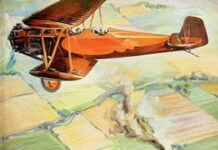We can’t say exactly when a new way of thinking invoked thoughts of heavier-than-air flight. However, we believe someone, somewhere took a second look at Leonardo da Vinci’s imaginative drawings, and wondered what if they could make one of them actually fly.

https://en.wikipedia.org/wiki/File:Leonardo_flying_machine.JPG
Discovery of the Laws of Motion
This would not have been possible but for centuries of innovative thought in the era following the middle ages where superstition and dogma prevailed.
Of course, this was not a consolidated movement. Indeed, much research into flying may have taken place in secret because the very thought of it challenged the established order. Many ideas may have fallen on sterile ground. Many experiments would have failed.
Hence, we only have a few surviving milestones that tell the story of early developments leading to the invention of the first heavier than air flying machines.
We should remember concepts of propulsion, drag, lift, and weight were still waiting to be discovered in those days. The only inspirations pioneers had were the flapping of bird wings overhead, as so eloquently captured in the drawings of Leonardo da Vinci (1452 – 1519).

https://en.wikipedia.org/wiki/Science_and_inventions_of_Leonardo_da_Vinci#/media/File:Leonardo_Design_for_a_Flying_Machine,_c._1488.jpg
However, these thoughts yielded nothing concrete as far as we know. The invention of the working airplane really only began when attention turned to the study of the forces governing flight through the air.
Italian physicist, astronomer, and engineer Galileo Galilei (1564 – 1652) conducted ground-breaking research into falling objects. He concluded the rate an object falls depends on the medium through which it is falling independent of its weight. And that it would fall forever in a vacuum.
Dutch physicist, mathematician, astronomer and inventor Christiaan Huygens (1629 – 1696) contributed greatly to contemporary understanding of mass, weight, momentum, force, and work. He began to explore the possibility of extra-terrestrial life in his final years, and dreamed of visiting faraway worlds he viewed through the telescope eyepiece he invented.
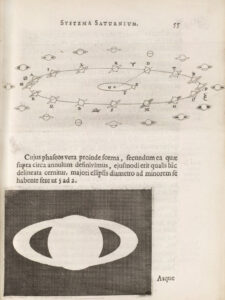
https://en.wikipedia.org/wiki/Christiaan_Huygens#/media/File:Huygens_Systema_Saturnium.jpg
However, it took the genius of mathematician, physicist, astronomer, and theologian Isaac Newton (1642 – 1727) to confirm the effect of mechanics and gravitation on orbits of the planets.
He defined three universal laws of motion:
· The relationship of any object
· The forces acting upon it
· The resulting motion occurring
Newton and others after him increased understanding of interplays between resistance, surface area and the density of fluid. Swiss mathematicians Daniel Bernoulli and Leonhard Euler, and British engineer John Smeaton took this a stage further, and laid the foundations for future aerodynamic feats.
Joining the Dots between Motion and Flight
George Cayley (1773 – 1857) was a British baronet who applied his engineering mind to aeronautics, and unmanned flight. He conceived the four principles of weight, lift, drag, and thrust, and designed the world’s first successful human glider.
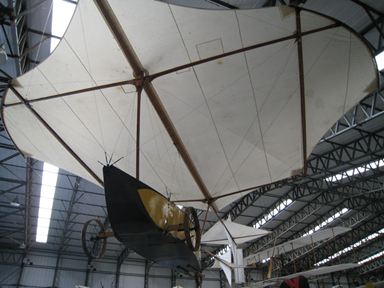
https://www.flickr.com/photos/beaty/1471434511/
George Cayley’s remarkably innovative design included a kite-shaped wing, and an adjustable tail plane at the rear comprising horizontal stabilizers and a vertical fin. He added a movable weight to trim the centre of gravity before successfully launching a scale model.
He dedicated his mind to advancing human flight, and built a biplane in 1849 a ten-year-old boy flew. It’s said he also built a second biplane in which his coachman glided across the heath in front of his baronial hall. However, we can’t guarantee it looked like this one with ‘twin flappers’, although this model bearing his name is in the San Diego Air and Space Museum.
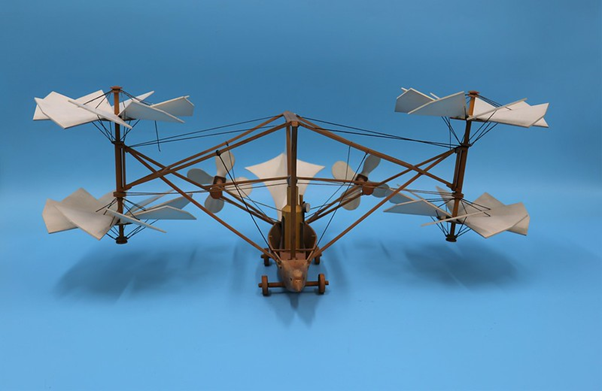
https://www.flickr.com/photos/sdasmarchives/49178629978/
Cayley used his grasp of weight, lift, drag, and thrust to conceive an arched, cambered wing with more lift than a flat one because of lower pressure at the top of the curve. His relatively long and narrow wings followed the organic design of birds.
But perhaps his greatest achievement was conceptualising biplane, and multiplane wings allowing maximum surface area in a strongly braced structure.
The birth of lighter-than-air flight in Russia emerges from history in frustrating bites. Perhaps the earliest recollection dates from 1784, when Catherine the Great banned balloon flights over Russia. She may have been trying to slow the westernization of her country these ‘fire-breathing aerostatic globes’ represented.
Russia’s next known attempts at lighter-than-air flight commenced in 1812 during the French invasion of Russia. The Emperor of Russia, Alexander 1 summoned German engineer Franz Leppich (also spelled Leppig) to construct ‘a large, fish-shaped airship’ as part of a plan to counter-attack Napoleon Bonaparte’s army.
Leppich was an inventor and musician born to a farming family who became famous. Anecdotal evidence suggests Napoleon was at the Moscow city gates and this was an urgent matter. Leppich and his assistants worked round the clock sewing the envelope from thick cloth, and attaching it to a 65-foot platform.
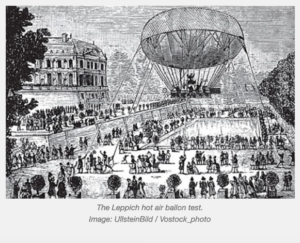
https://bigbook2019.home.blog/2019/03/16/a-load-of-hot-air
The design called for forty rowers to paddle the airship, help the gunners aim their cannons, and drop fuse bombs on the enemy below. However, the paddles kept breaking and they aborted the project. But this did not spell the end of Russia’s military ambitions in the air.
The next mention of Russia airships was in 1854, when British warships were blockading the imperial capital Saint Petersburg from the ocean during the Crimean War. Army Lieutenant Ivan Mantsev suggested dropping incendiary bombs on the Russia navy, perhaps along the lines in this photo but they ran out of time.

https://www.alamy.com/the-crimean-war-opening-of-the-bombardment-of-sebastopol-chapmans-battery-1854-image240576116.html
Official interest took off in 1869, when Russia began studying military applications for balloons. There is unverified evidence from a single source a detachment formed to operate airships in 1869.
Not much happened after that until Otto Lilienthal (1848 – 1896) created the bridge that the American Wright brothers would cross a few decades later. His studies of the forces operating on wings in a stream of air in the late 1870’s set the stage for what followed.

https://en.wikipedia.org/wiki/File:Whitestorkflight.png
German engineer Otto Lilienthal was arguably the first pioneer who trusted his ideas sufficiently to fly them. He built an artificial hill from which to launch some of the over 2,000 flights he made in a series of hang gliders.
By 1891 he was making jumps and flights covering 82 feet, while using updrafts to remain stationary above the ground. His 1893 flight set a world record of 820 feet that endured until after his death. He died in 1896 after his glider stalled and he could not regain control.
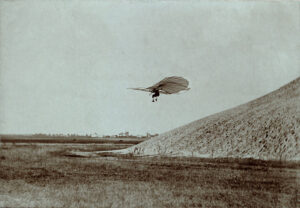
https://en.wikipedia.org/wiki/File:Otto_Lilienthal_gliding_experiment_ppmsca.02546.jpg
Otto Lilienthal’s death proved the inspiration that kickstarted the Wright brothers’ work. It’s believed Wilbur said they needed little time to focus on wing design. “Men already know how to construct wings,” Wilbur explained in 1901. “Which when driven through the air at sufficient speed will not only sustain themselves but also that of the engine, and of the engineer as well.”
“Lilienthal was without question the greatest of the precursors, and the world owes to him a great debt.” Although after two years of experimenting he did discover Lilienthal’s wings actually did need more work.

https://www.loc.gov/resource/ppmsca.02545/
Konstantin Danilyevsky (the future father of ‘Russian cosmonautics) again explored the idea of bombing from the air in 1898. He imagined a giant airship 200 feet long, propelled by 8 steam engines at 25 mph.
In his fertile mind, it would transport 200 people and 14 tons of cargo. However, he was a visionary ahead of his time. Russian forces pleaded for airships during the Russo-Japanese war of 1904 / 1905 for observation purposes, but they were unanswered too.

https://www.rbth.com/defence/2014/08/11/taking_war_into_the_skies_the_age_of_the_airship_38919.html
At that time Russia may have been reacting aluminum and sodium hydroxide to produce hydrogen gas on site. The Grantsville Gazette reports this was a resource-heavy process able to fill a 14,000 cubic foot balloon in 30 minutes.
However, there was still one more piece needed to complete the 19th century story of lighter than air flight. American astronomer and physicist Samuel Langley was a pioneer of note, and one time Secretary of the Smithsonian Institution. His rubber-band-powered model aircraft flew well, although the piloted ones were less unsuccessful.
He discovered an aircraft of a particular size would need less propulsive power as speed increased. After several successful flights with steam powered models, he launched a full-size version with his assistant at the tiller.
He abandoned his work after it crashed into a river. This was a few days before the Wright Brothers successfully made their first powered flight.





